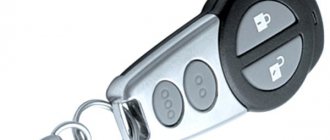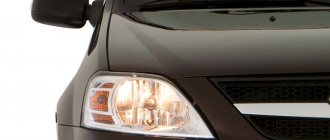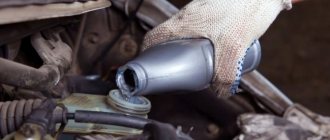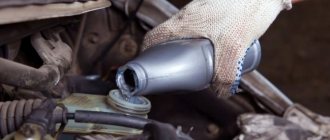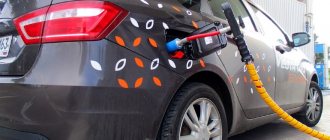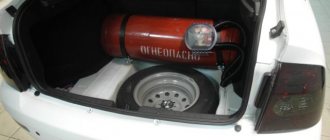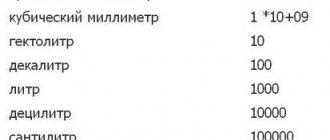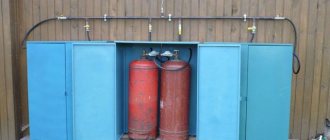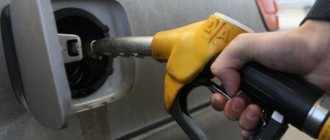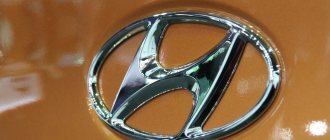When using methane, the car does not lose much in acceleration dynamics compared to driving on gasoline. However, you don’t expect easy and fast overtaking on the highway from an ordinary Largus. It feels like acceleration to 100 km/h in Largus on methane lasts a couple of seconds longer than in the gasoline version. Official manufacturer data: 14.4 seconds on methane and 13.4 seconds on gasoline. Contrary to the myth that exists among motorists, there are no differences in the ratio of crankshaft revolutions and vehicle speed when using different fuels. And it cannot be. The engine spins up to 3000 rpm at a speed of almost 120 km/h. Of course, when overtaking on the highway, no, no, and you’ll switch to a lower gear. In this case, the gas mixture begins to be enriched with gasoline. This is done to reduce the thermal effect on the engine. In addition, the engine always starts on gasoline. It is these two modes of operation of the power unit that add several rubles spent on gasoline to the cost of a kilometer of travel on methane.
How many kilometers can you drive on methane?
Table of advantages and disadvantages of propane and methane
| Factor | Propane | Methane |
| Relatively cheaper than gasoline | 1.8-2 times | 3 times cheaper |
| Consumption relative to gasoline (per 10 liters) | 11-11.5 liters | 8-8.5 cubes |
| Average tank weight | 20-30 kg | 60-125 kg |
| Fuel reserve for an average set ( kilometers ) | 600-1000 km | 250-350 km |
CNG filling station infrastructure
Before the trip, this question seemed to us one of the most important. Now we consider it the most important. The car can be used within the city without any doubt. In Tolyatti, for example, where there are only two methane gas stations for a city of seven hundred thousand, this will generally cause moderate inconvenience. But when traveling around Russia everything is even worse. Our route was compiled taking into account the infrastructure of CNG filling stations, which are located in Togliatti, Syzran, Penza, Ryazan, Tula, Kaluga and Smolensk. That is why we were forced to deviate from the shortest route and drive into the city.
To obtain up-to-date information, we used the website AGNKS.RU, where up-to-date user information on all methane gas stations in Russia is collected in map format.
To obtain up-to-date information, we used the website AGNKS.RU, where up-to-date user information on all methane gas stations in Russia is collected in map format.
In some cities, we could choose from two gas stations, making it more comfortable to plot our route in the navigator. Theoretically, we could cover the entire route using methane. But one of the tasks was to find out what the real power reserve is on one cylinder. So we flew through the first refueling in Syzran (only a few hundred meters from the M5 highway) “in full sail” and assumed that there would be enough methane to reach Penza (the path from Tolyatti to Penza is 350 km). Not enough.
How much does one cubic meter of gas cost?
Retail price of natural gas for the population
| Item no. | Units | Retail gas (including VAT) |
| 3 | rub./1 cubic meter m, reduced to standard conditions | 6,47 |
| 4 | rub./1000 cubic meters m, reduced to standard conditions | 6363,1 |
| 5 | rub./1000 cubic meters m, reduced to standard conditions | 6363,1 |
Equipment manufacturability
I already wrote that the 5th generation of gas equipment has now appeared, and soon the 6th and the sixth will appear. So propane can work with these generations, but methane cannot! And most likely he won’t be able to!
To briefly recall, in the 5th and 6th generations, gas is supplied liquid to the fuel injection system, similar to gasoline. Propane can work with this because it is stored in liquid cylinders, but methane is stored in gaseous form! And such a topic will not work for him, he can use the 4th generation of equipment at most, EVERYTHING IS THE LIMIT! By the way, you can read about the difference between the 4th and 5th generations here .
What do these 5th and 6th generations give, oh guys, a lot of things! Consumption is about the same as on gasoline, there is practically no loss of power! Cold starts can be on gas, and much more! That is, you practically do not see the difference.
Fuel consumption for 5 - 6 generations is the same as for gasoline, that is, 8 - 10 liters (again for a 1.6 liter engine)
I think that's enough evidence. Now let's watch a short video version.
The vote is now on whether you will vote for propane or methane, I'm interested in your thoughts.
This is where I end, I think my article was useful to you, read our AUTOBLOG.
( 27 votes, average: 4.15 out of 5)
What is the difference between propane and methane?
Propane
is liquefied petroleum gas, stored in cylinders in a liquid state under a pressure of 10–16 atmospheres and measured in liters.
... Methane
is compressed natural gas. Simply put, it is a gas that is produced naturally in nature.
Interesting materials:
What is the lowest temperature in Turkey? What is the discount on a child's plane ticket? What is the discount on a child's Russian Railways ticket? What is the speed of the metro in St. Petersburg? What is the best baby formula? What is the daily dose of vitamin D? What is the daily kcal requirement? What is the daily requirement for vitamin D? What is the rash associated with mononucleosis? What kind of vest does the Navy have?
Comparison of two types of fuel
There are significant differences between gases. This applies to storage and operation (use). Applicable to vehicles:
- Methane is an environmentally friendly natural gas, produced in deposits from the bowels of the earth. Cars with methane gas equipment are marked - CNG (Compressed Natural Gas) compressed natural gas or CNG (compressed);
- Propane-butane is a mixture of two gases obtained from the oil industry. Marking LPG (Liquified Petroleum Gas) or CIS (liquefied petroleum gas).
Storage and transportation of methane as automobile fuel is carried out under a pressure of 200-250 atmospheres (measured in cubic meters), propane-butane 14-18 atmospheres. (in liters). Both types of fuel are widely used in passenger cars, trucks, passenger vehicles and agricultural machinery. In internal combustion engines: gasoline, diesel (gas diesel), gas.
Let's consider the main pros and cons of cars running on methane and propane, in such indicators as:
- Price and design differences between gas equipment.
- Financial and economic benefits.
- Motor characteristics.
- Safety.
- Availability of gas stations.
- Issues related to ecology.
Differences between methane gas and propane gas
The cost and installation of gas equipment running on propane will be cheaper than installing gas equipment on methane. The numbers are impressive, the difference in price can be a colossal gap. For example, a 4th generation propane gas installation for a passenger car can cost on average from 25-35 thousand rubles. from 60 thousand rubles in the cheapest version . With commercial vehicles it is even more complicated.
The main contribution to the difference is the price of gas cylinders and their installation. And if this fact is applied to powerful cars or trucks, where more than one or two cylinders are installed, then the conversion will cost a tidy sum.
Since methane gas is compressed under high pressure, thick-walled, heavy containers are required for its transportation. In addition, methane vessels are only cylindrical in shape, which can make it difficult to choose a place for installation and take up the useful volume of the luggage compartment. In terms of mass, there is an alternative solution - composite cylinders of different sizes, but their price is too high (for example, an 80-liter vessel will cost from 35,000 rubles complete with shut-off valves and fasteners).
Propane is more profitable in this regard - there is a huge selection of relatively light, cheap toroidal (for the spare wheel niche) or cylindrical cylinders.
The gas reducer and fuel lines are also different (for methane they use metal ones with a protective coating, again due to pressure). Propane gas equipment uses copper or plastic. A pressure gauge is installed with the CNG reducer to control the pressure and, as an option, an electronic sensor with an indication output to the passenger compartment - a gas fuel meter.
Methane equipment has its own filling device. Otherwise, gas systems are similar.
Gas consumption and payback
When comparing and choosing which gas equipment to install on a car, methane or propane, first of all they consider the payback period of the equipment.
For obvious reasons, it is difficult to calculate the exact economics within the framework of this article (jumps in prices for fuel and equipment, vehicle features, depreciation). Therefore, we will make an average calculation, where everyone, knowing the parameters of their car, can substitute them, obtaining more specific figures.
- the price of gasoline is 43 rubles, propane is 20 rubles, methane is 17 rubles;
- mileage per month 3000 km;
- car (ICE 4 cylinders, gasoline, gasoline consumption per 100 km run 10 liters - 12,900 rubles per month);
- cost of gas equipment: propane 30,000 rubles, methane 60,000 rubles.
It is believed that the consumption of propane-butane in relation to gasoline is 10-35% higher. Let’s take the maximum value – 35%, so the consumption coefficient relative to gasoline will be 1.35. It turns out that with propane the consumption per hundred will be 13.5 liters. 405 l per month. gas – 8100 rub. Benefit 37% or 4800 rubles.
Methane is measured in cubic meters, its consumption compared to gasoline is on average 10% less (derived experimentally) - coefficient. 0.9. In our case – 9 m3. At the end of the month, 270 cubic meters - 4590 rubles. Almost 65% more profitable or 8310 rubles.
1. CIS (gas cost/benefit): 30,000/4800= 6.25 months or (recoupment*mileage): 6.25*3000= 18,750 km. mileage ;
2. CNG – 60000/8310= 7.22 months . or – 7.22*3000= 21661 km .
Where did the 10% figure come from?
As can be seen from the table, the physicochemical properties of different types of fuel differ significantly, which determines the difference in the degree of impact on the engine and vehicle performance characteristics. It depends, first of all, on the time of year, warming up with gasoline, the frequency of starts of a cooled engine, on the car model, on the choice of gas equipment, its settings, as well as the degree of willingness to take risks or not, the durability of the gearbox membrane is not a high warm-up temperature, for example, up to 30g.
Examples of calculating the payback of 4th generation gas equipment • Require topping up
Fuel consumption for an enterprise can be calculated independently, but when checking by inspection bodies, it is best to say that the enterprise takes into account the recommendations of the Ministry of Transport of the Russian Federation, but wants to independently calculate this indicator due to the specifics of the vehicles. For 2022, enterprises that have a fleet of vehicles can calculate their fuel consumption independently, or taking into account the requirements of the Ministry of Transport of the Russian Federation.
| Car name | Methane consumption per 100 km | Methane costs per day | Gasoline costs per day |
| Hyundai Sonata | 8 m3 | 8 m3*12.5 rub.*4= 400 rub. | 8 l*35 rub.*4= 1120 rub. |
| PAZ-32050R | 25 m3 | 25 m3*12.5 rub.*5.69= 1778 rub. | 25 l*35 rub.*5.69= 4979 rub. |
| The calculations are slightly different, since propane consumption increases by 15%. | |||
| Gazelle | 20 l+15%=23 l | 23 l*17.5 rub.*3= 1207.5 rub. | 20 l*35 rub.*3= 2100 rub. |
| Hyundai Solaris | 10 l+15%=11.5 l | 11.5 l*17.5 rub.*5= 1006.25 rub. | 10 l*35 rub.*5= 1750 rub. |
How to take into account the norms in waybills: Require topping up
| I set the gasoline consumption when operating the LPG, so it’s probably half a tank of 35 liters, I haven’t used gasoline in a year, sometimes I specifically drive 20-50 kilometers on gasoline, because otherwise it gets old and loses its properties. Explanation: In this formula, the fuel standard is indicated for the KAMAZ vehicle brand; for other brands of vehicles, this formula can also be used, taking as a basis the indicators for a specific vehicle brand. |
How to determine gas consumption • Is it really worth doing this and why is gas better than gasoline and diesel?
My car park! • Require topping up
| Methane consumption per 100 kilometers - comparison with propane and gasoline The main reasons for high wholesale prices for liquefied hydrocarbon gases are a reduction in supply volumes under direct contracts for February for some producers by 30, a high level of export quotations, a reduction in refining against the background of a decrease in oil production under the OPEC agreement , RTS Vice President Rinat Fattakhov commented to Kommersant. And for methane, these figures reach 11353 kcal kg and 8210 kcal per liter of production, as a result of which consumption rates fluctuate in the ratio 85-93. |
Comparison of methane consumption with gasoline • Therefore, every liter counts, even better if you managed to save it.
